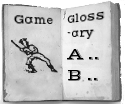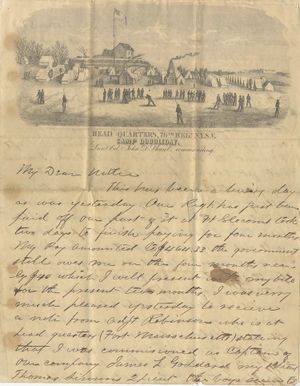Drive Ball: Difference between revisions
Bsallardice (talk | contribs) No edit summary |
Bsallardice (talk | contribs) No edit summary |
||
| (One intermediate revision by the same user not shown) | |||
| Line 13: | Line 13: | ||
<p><em>Drive Ball’ is a game for two players only, who are placed each with a bat, at some distance from, and facing each other. The ball is then knocked back and forth, from one to the other, each endeavoring to drive it as far as possible, where it must be picked up and knocked back to the other player, who is at liberty to advance as near as he pleases. If he advance too near, however, his opponent will be likely, with a vigorous stroke, to force him to retreat again. The space of ground passed over will readily show which is the victor.</em></p> | <p><em>Drive Ball’ is a game for two players only, who are placed each with a bat, at some distance from, and facing each other. The ball is then knocked back and forth, from one to the other, each endeavoring to drive it as far as possible, where it must be picked up and knocked back to the other player, who is at liberty to advance as near as he pleases. If he advance too near, however, his opponent will be likely, with a vigorous stroke, to force him to retreat again. The space of ground passed over will readily show which is the victor.</em></p> | ||
|Sources=<p><span>[1] <span style="text-decoration: underline;">The Boy's Book of Sports; a Description of the Exercises and Pastimes of Youth</span> (New Haven, S. Babcock, 1835), 24 pages. Summarized in David Block, <span style="text-decoration: underline;">Baseball before We Knew It</span> (University of Nebraska Press, 2005), page 198. <span> See also Babcock's <span style="text-decoration: underline;">Juvenile Pastimes; or Girls' and Boys' Book of Sports</span><span> (New Haven, S. Babcock), 16 pages, per David Block,</span><span> page 212.</span></span></span></p> | |Sources=<p><span>[1] <span style="text-decoration: underline;">The Boy's Book of Sports; a Description of the Exercises and Pastimes of Youth</span> (New Haven, S. Babcock, 1835), 24 pages. Summarized in David Block, <span style="text-decoration: underline;">Baseball before We Knew It</span> (University of Nebraska Press, 2005), page 198. <span> See also Babcock's <span style="text-decoration: underline;">Juvenile Pastimes; or Girls' and Boys' Book of Sports</span><span> (New Haven, S. Babcock), 16 pages, per David Block,</span><span> page 212.</span></span></span></p> | ||
<p>[2] F. B. Sanborn, <em>New Hampshire Biography and Autobiography</em> (Private Printing, Concord NH, 1905), page 13.</p> | <p>[2] F. B. Sanborn, <em>New Hampshire Biography and Autobiography</em> (Private Printing, Concord NH, 1905), page 13.</p> | ||
|Source Image=Camp dday ltrhd.jpg | |Source Image=Camp dday ltrhd.jpg | ||
| Line 19: | Line 18: | ||
<p>[B] Block also spies another possible reference to drive ball in an 1862 engraving at, of all places, Camp Doubleday, a Civil War facility evidently named for General Abner Doubleday of Cooperstown NY.</p> | <p>[B] Block also spies another possible reference to drive ball in an 1862 engraving at, of all places, Camp Doubleday, a Civil War facility evidently named for General Abner Doubleday of Cooperstown NY.</p> | ||
<p>"In the foreground of the illustration two soldiers face each other with bats, one striking a ball. Since no other players are involved, the only game that seems to correlate to the image is, in fact, drive ball. If not for Abner Doubleday's association, we would pay this little heed, but it is a matter of curiosity, if not amusement, to place baseball's legendary noninventor in such close proximity to a game involving a bat and ball." David Block, <span style="text-decoration: underline;">Baseball Before We Knew It </span>(UNebraska, 2005), page 198. See also [[1862.104]]</p> | <p>"In the foreground of the illustration two soldiers face each other with bats, one striking a ball. Since no other players are involved, the only game that seems to correlate to the image is, in fact, drive ball. If not for Abner Doubleday's association, we would pay this little heed, but it is a matter of curiosity, if not amusement, to place baseball's legendary noninventor in such close proximity to a game involving a bat and ball." David Block, <span style="text-decoration: underline;">Baseball Before We Knew It </span>(UNebraska, 2005), page 198. See also [[1862.104]]</p> | ||
<p>An old "fogy" recalled playing drive ball and wicket as a youth. See the New London (CT) Daily, Feb 24, 1857</p> | <p>An old "fogy" recalled playing drive ball and wicket as a youth. See the New London (CT) Daily, Feb 24, 1857. Another in the Waterbury (CT) Democrat, July 11, 1908 recalls that 60 years ago "the three or four clerks from the three or four stores enjoying a game of drive ball on the green."</p> | ||
<p>For a later description of the game, see "Games we used to play," NY Sun, Oct. 14, 1900. Here, the ball is hit with the hand, not a bat.</p> | |||
<p> </p> | <p> </p> | ||
|Query=<p>These ambiguous bits appear to be Protoball's only references to drive ball; can we find out more about the nature of its play?</p> | |Query=<p>These ambiguous bits appear to be Protoball's only references to drive ball; can we find out more about the nature of its play?</p> | ||
Latest revision as of 07:13, 28 July 2023
| Game | Drive Ball |
|---|---|
| Game Family | Fungo |
| Location | New England |
| Regions | US |
| Eras | 1800s, Predecessor |
| Invented | No |
| Tags | |
| Description | [1] Drive ball: An 1835 book published in New Haven describes drive ball. David Block's summary: "In this activity, two boys with bats face each other, taking turns fungoing the ball. When one boy hits the ball, the other has to retrieve it as quickly as he can, then fungo it back from the spot he picked it up." From the 1835 text: "'Drive Ball’ is a game for two players only, who are placed each with a bat, at some distance from, and facing each other. The ball is then knocked back and forth, from one to the other, each endeavoring to drive it as far as possible, where it must be picked up and knocked back to the other player, who is at liberty to advance as near as he pleases. If he advance too near, however, his opponent will be likely, with a vigorous stroke, to force him to retreat again. The space of ground passed over will readily show which is the victor." A 1849 chapbook from Babcock also mentions drive ball as the last mentioned of six common games played with a ball, naming "base-ball, trap ball, cricket, up-ball, catch-ball and drive ball." -- [2] Drive: A ball game, listed along with the Old Cat games and Baseball, is mentioned in the memoirs of a New Hampshire man born in 1831. The rules of this game are not given. It may not have been a baserunning game. Drive Ball’ is a game for two players only, who are placed each with a bat, at some distance from, and facing each other. The ball is then knocked back and forth, from one to the other, each endeavoring to drive it as far as possible, where it must be picked up and knocked back to the other player, who is at liberty to advance as near as he pleases. If he advance too near, however, his opponent will be likely, with a vigorous stroke, to force him to retreat again. The space of ground passed over will readily show which is the victor. |
| Sources | [1] The Boy's Book of Sports; a Description of the Exercises and Pastimes of Youth (New Haven, S. Babcock, 1835), 24 pages. Summarized in David Block, Baseball before We Knew It (University of Nebraska Press, 2005), page 198. See also Babcock's Juvenile Pastimes; or Girls' and Boys' Book of Sports (New Haven, S. Babcock), 16 pages, per David Block, page 212. [2] F. B. Sanborn, New Hampshire Biography and Autobiography (Private Printing, Concord NH, 1905), page 13. |
| Source Image | |
| Comment | [A] One might infer that this came was won when one player hit the ball past some agreed end-line. [B] Block also spies another possible reference to drive ball in an 1862 engraving at, of all places, Camp Doubleday, a Civil War facility evidently named for General Abner Doubleday of Cooperstown NY. "In the foreground of the illustration two soldiers face each other with bats, one striking a ball. Since no other players are involved, the only game that seems to correlate to the image is, in fact, drive ball. If not for Abner Doubleday's association, we would pay this little heed, but it is a matter of curiosity, if not amusement, to place baseball's legendary noninventor in such close proximity to a game involving a bat and ball." David Block, Baseball Before We Knew It (UNebraska, 2005), page 198. See also 1862.104 An old "fogy" recalled playing drive ball and wicket as a youth. See the New London (CT) Daily, Feb 24, 1857. Another in the Waterbury (CT) Democrat, July 11, 1908 recalls that 60 years ago "the three or four clerks from the three or four stores enjoying a game of drive ball on the green." For a later description of the game, see "Games we used to play," NY Sun, Oct. 14, 1900. Here, the ball is hit with the hand, not a bat. Edit with form to add a comment |
| Query | These ambiguous bits appear to be Protoball's only references to drive ball; can we find out more about the nature of its play? Is there evidence that drive ball included base-running? [A] a description of the game in Smalley's Magazine (1891, vol. 9, issue 8, p. 10) says no. [ba] Edit with form to add a query |
| Has Supplemental Text |
Comments
<comments voting="Plus" />

